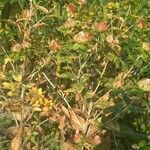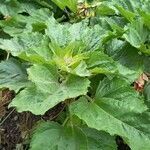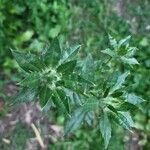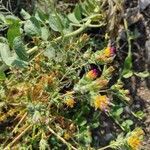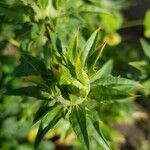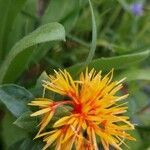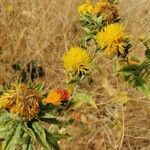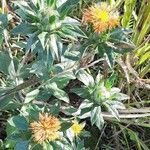| Therapeutic use
|
Hair loss (flower), Amenorrhea (flower), Analgesics (flower), Antifungal agents (flower), Anti-inflammatory agents (flower), Asthma (flower), Blister (flower), Bronchitis (flower), Cardiotonic agents (flower), Carrageenan (flower), Paralysis of brain and spine (flower), Common cold (flower), Cough (flower), Diuretics (flower), Dysmenorrhea (flower), Dysuria (flower), Expectorants (flower), Furunculosis (flower), Genital diseases, female (flower), Hair dyes (flower), Heart diseases (flower), Hematologic diseases (flower), Hemorrhage (flower), Hemorrhoids (flower), Hypercholesterolemia (flower), Hypnotics and sedatives (flower), Inflammation (flower), Jaundice (flower), Laxatives (flower), Leprosy (flower), Liver injury (flower), Liver diseases (flower), Measles (flower), Menstruation-inducing agents (flower), Mouth diseases (flower), Nervous system diseases (flower), Poliomyelitis (flower), General tonic for rejuvenation (flower), Scabies (flower), Skin care (flower), Skin diseases (flower), Splenomegaly (flower), Taste disorders (flower), Urinary calculi (flower), Urination disorders (flower), Vitiligo (flower), Body odor (flower), Diaphoretic (flower), Anthelmintics (fruit), Antirheumatic agents (fruit), Appetite stimulants (fruit), Arteriosclerosis (fruit), Atherosclerosis (fruit), Calculi (fruit), Cathartics (fruit), Cholesterol (fruit), Common cold (fruit), Depressive disorder (fruit), Digestive system diseases (fruit), Diuretics (fruit), Dysmenorrhea (fruit), Dysuria (fruit), Eczema (fruit), Edema (fruit), Fatigue (fruit), Hemorrhage (fruit), Jaundice (fruit), Laxatives (fruit), Menstruation-inducing agents (fruit), Mental disorders (fruit), Pharyngitis (fruit), Respiratory tract infections (fruit), Scabies (fruit), Vitiligo (fruit), Appetite stimulants (leaf), Calculi (leaf), Common cold (leaf), Cough (leaf), Deafness (leaf), Delirium (leaf), Diuretics (leaf), Dysuria (leaf), Eye diseases (leaf), Fatigue (leaf), Genital diseases, female (leaf), Graves ophthalmopathy (leaf), Hematologic diseases (leaf), Laxatives (leaf), Metabolism (leaf), Photosensitivity disorders (leaf), Skin care (leaf), Urination disorders (leaf), Urologic diseases (leaf), Vaginal diseases (leaf), Tonsillitis (plant exudate), Diuretics (root), Acne vulgaris (seed), Anti-bacterial agents (seed), Antifungal agents (seed), Anti-inflammatory agents (seed), Antinematodal agents (seed), Antipruritics (seed), Antirheumatic agents (seed), Aphrodisiacs (seed), Arthritis (seed), Atherosclerosis (seed), Cathartics (seed), Chest pain (seed), Cholinesterase inhibitors (seed), Common cold (seed), Constipation (seed), Diuretics (seed), Ear diseases (seed), Eczema (seed), Exanthema (seed), Eye diseases (seed), Flatulence (seed), Hematologic diseases (seed), Hypercholesterolemia (seed), Insulin regulation (seed), Laxatives (seed), Liver diseases (seed), Measles (seed), Pain (seed), Parasympatholytics (seed), Pharyngitis (seed), Increase physical endurance, strength and stamina (seed), Postnatal care (seed), Pruritus (seed), General tonic for rejuvenation (seed), Scabies (seed), Ulcer (seed), Vitiligo (seed), Wounds and injuries (seed), Scarlet fever (seed), Diaphoretic (seed), Amenorrhea (unspecified), Anodyne (unspecified), Apoplexy (unspecified), Astringent (unspecified), Bactericide (unspecified), Blood (unspecified), Bruise (unspecified), Diaphoretic (unspecified), Discutient (unspecified), Diuretic (unspecified), Dropsy (unspecified), Dye (unspecified), Dysmenorrhea (unspecified), Emmenagogue (unspecified), Eruption (unspecified), Food-Dye (unspecified), Fungicide (unspecified), Gynecopathy (unspecified), Heart (unspecified), Laxative (unspecified), Lenitive (unspecified), Measles (unspecified), Purgative (unspecified), Rennet (unspecified), Rheumatism (unspecified), Rubefacient (unspecified), Scarlatina (unspecified), Sedative (unspecified), Skin (unspecified), Sudorific (unspecified), Tumor (unspecified), Wound (unspecified), Alterative (unspecified), Puerperium (unspecified), Sore (unspecified), Stimulant (unspecified), Trauma (unspecified), Abortifacient (unspecified), Antidote (unspecified), Boil (unspecified), Candida (unspecified), Fever (unspecified), Hemorrhage (unspecified), Inappetence (unspecified), Jaundice (unspecified), Placenta (unspecified), Uterotonic (unspecified), Hair loss (unspecified), Antirheumatic agents (unspecified), Arteriosclerosis (unspecified), Cardiovascular diseases (unspecified), Common cold (unspecified), Fibrosis (unspecified), Laxatives (unspecified), Menopause (unspecified), Skin diseases (unspecified), Veterinary medicine (unspecified), Wounds and injuries (unspecified), Cooling effect on body (unspecified), Antirheumatic agents (whole plant), Paraplegia (whole plant), Pruritus (whole plant), Ulcer (whole plant), Wounds and injuries (whole plant)
|
